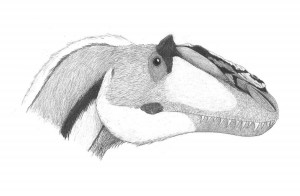MONDAY, 14 MAY 2012
The fossils include part of the Yutyrannus tail, and crucially, its skull. They reveal the sharp teeth and pointed head of a typical theropod – a carnivore that walked on its hind legs. Although smaller than its T.rex cousin, Yutyrannus weighed 1.4 tons and is by far the largest feathered dinosaur ever to have been discovered; 40 times heavier than Beipiaosaurus, the previously plumed record-holder.The paper, published in Nature, raises intriguing questions as to why some of these scaly reptiles developed this ‘fuzzy down’-like plumage typical of a newly hatched duckling. The six inch long feathers of Yutyrannus were only simple filaments, certainly not adequate for flight, supporting the theory that they evolved for insulation. The surrounding soil dates back 125 million years to the mid-Cretaceous period; and this was thought to be a particularly chilly time. Although it is not known whether Yutyrannus was warm or cold blooded, even a thin insulating plumage could aid survival in these climates. Conversely, the feathers may have been used in mating displays, hinting at complex behaviours not traditionally associated with these terrifying lizards.
Feathers are notoriously hard to preserve in the fossil record, so the true extent of feathered dinosaurs may never be known. The sheer size of Yutyrannus however is decisive, as we can now say with confidence that feathers were not solely evolved for flight. Instead, evolution hijacked existing features of sexual selection or adaptations to the cold to propel dinosaurs into the skies.
Written by Zac Baynham-Herd
DOI:10.1038/nature10906

